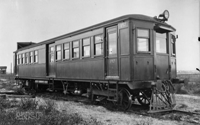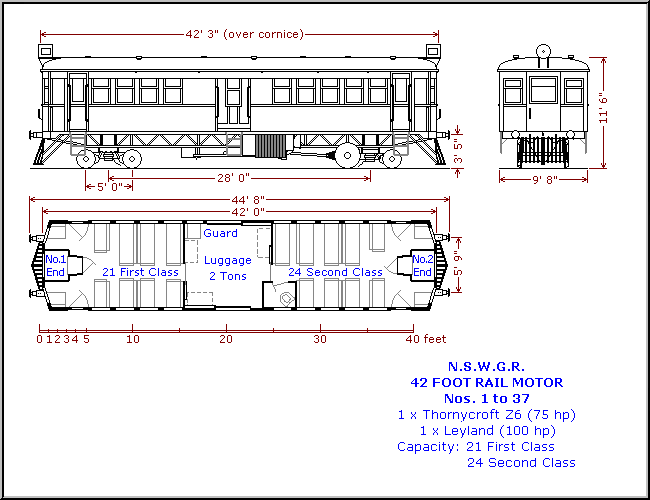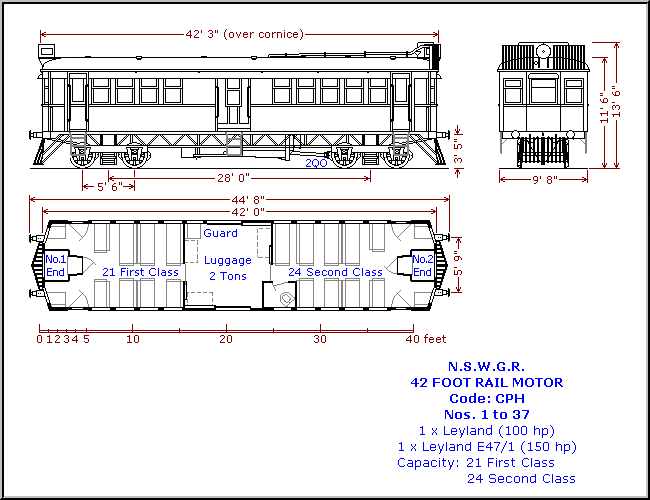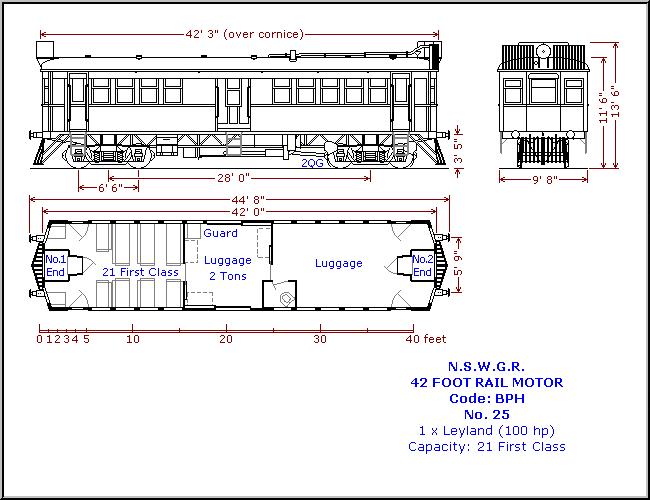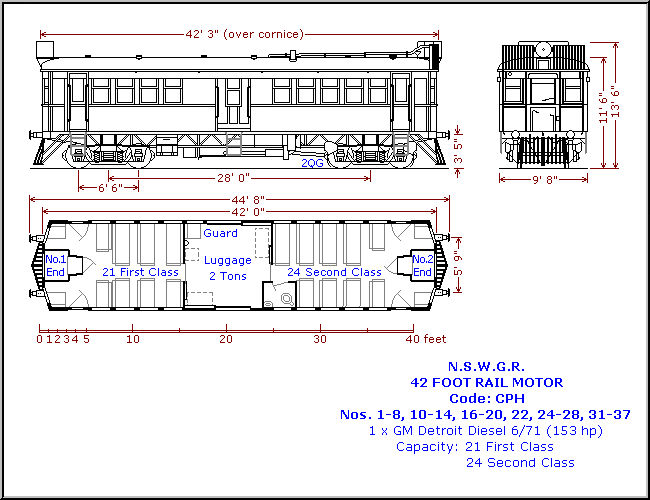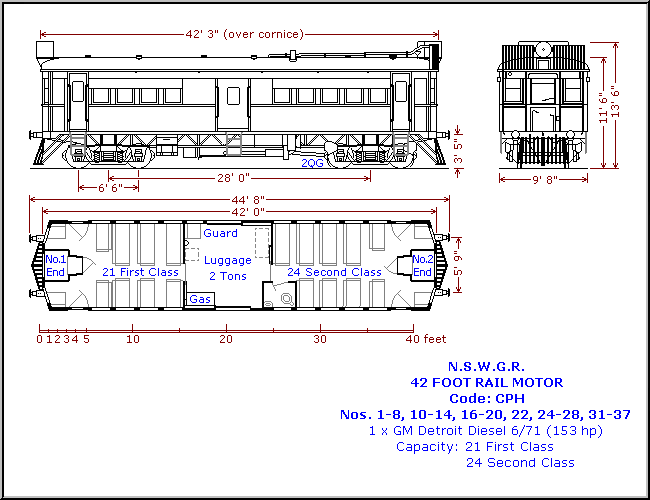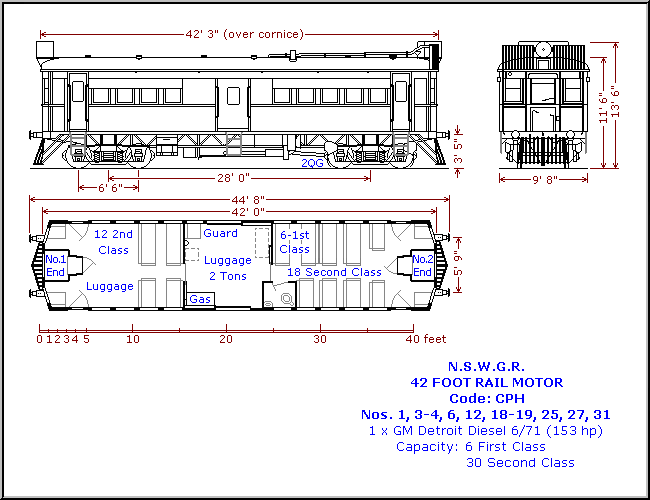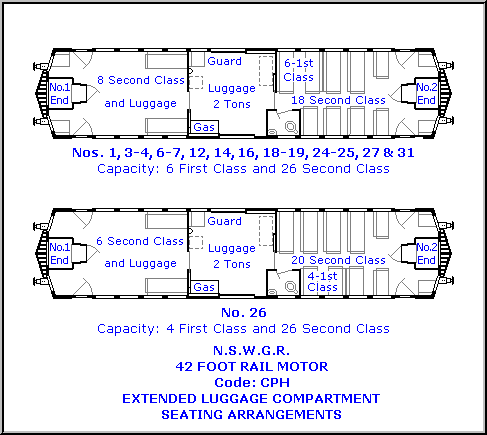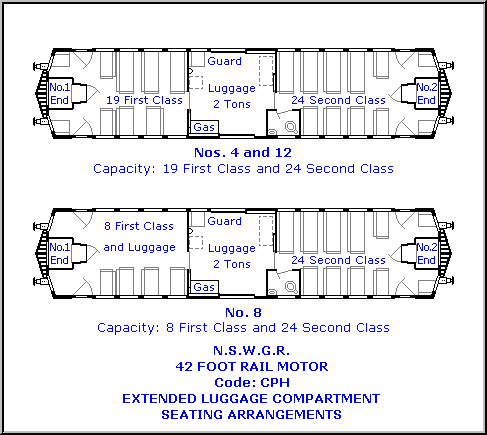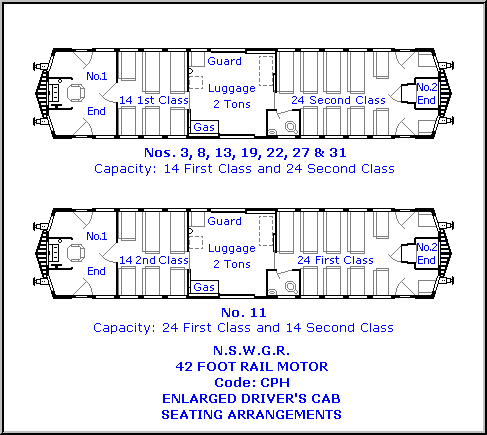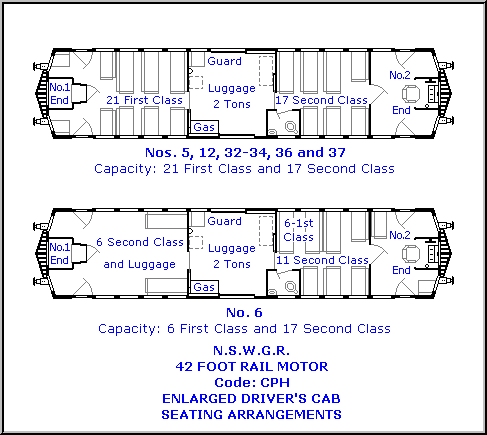|
|
INTRODUCTION
![]() he 42-foot Rail Motor emerged from plans by the New
South Wales Railways to build a self-propelled passenger vehicle for use throughout
the state using the experience gained from the two prototype Rail Motors No.1 and No.2. The 37 vehicles of this class would serve for a period of over sixty years and were known
colloquially as Tin Hares (as they were introduced at the same time as the tin hare into greyhound racing). Later they were given the
coding CPH and are now more generally known as the CPH Class or as "42-Footers".
he 42-foot Rail Motor emerged from plans by the New
South Wales Railways to build a self-propelled passenger vehicle for use throughout
the state using the experience gained from the two prototype Rail Motors No.1 and No.2. The 37 vehicles of this class would serve for a period of over sixty years and were known
colloquially as Tin Hares (as they were introduced at the same time as the tin hare into greyhound racing). Later they were given the
coding CPH and are now more generally known as the CPH Class or as "42-Footers".
CONSTRUCTION
The New South Wales Government Railways' Design Office prepared the plans for the car body using Rail Motor No.2 as the basis for the layout and a new lighter underframe was developed. Construction of these new vehicles took place in the Eveleigh Carriage Works.
The 42-foot Rail Motor was designed to run as an independent vehicle, which meant that the underframe could be made much lighter in design, thereby reducing the overall weight. The lighter underframe was achieved by making the two main longitudinal members from all steel, modified Warren trusses and these gave good strength as well as light weight. This new underframe design was believed to be unique in railway vehicles, although some Sydney trams had similar type frames dating back to 1908. The Modified Warren Trusses made extensive use of electric arc welding, the first time this technique was used in a NSW rail vehicle. Timbers sch as Queensland yellow wood, cedar and pine were used in the body construction to ensure the overall weight of the vehicle was kept to a minimum. They were constructed along the conventional carriage building techniques of the period by having a separate wooden body on a steel underframe.

An early photograph of Rail Motor
No.3 before its completion at Eveleigh Carriage Works
Contrast the large wheels on the driving axle with the smaller wheels on the
other axles
Photo: The Preston Collection
The body was divided into 3 compartments, seating up to 52 passengers and 2 crew. The First Class section (at the No.1 End) accommodated 21 passengers while the Second Class section accommodated 24 at the No.2 End. The centre Guard's compartment separated the two passenger compartments and provided the necessary area for the carriage of parcels and mail. This compartment could seat up to seven Second Class passengers on wooden slatted fold-down seats during crush periods. Two driving cabs were positioned at each end within the saloon areas. Entry to the cab was gained through a door in the back that opened into the passenger compartment and also served as the driver's seat back. The driving controls were arranged to allow the vehicle to be driven from either end and this meant the vehicle did not have to be turned at a terminus for the return journey.
The cab occupied the centre part of the car and single seats were mounted on either side for passenger use. These seats were in great demand by young and old alike because they had a forward aspect and overlooked the driver's controls providing an excellent opportunity for the study of rail motor driving techniques. A compartment was located in the Second Class area housing the dry hopper toilet and wash basin. This facility did not have running water and a large watering can, that was filled by the guard, was provided for the convenience and hygiene of the passengers.
The original seating was a fixed type and they were grouped in facing pairs. One side of the aisle had a two-seat arrangement while the opposite side had a three-seat arrangement. These seats were small and even with additional upholstery proved rather uncomfortable. From 1936 Hale and Kilburn turnover seating was progressively fitted to all cars. The roof was finished with canvas and navy dressing which was laid on the wooden roof timbers. Roof ventilators were provided.
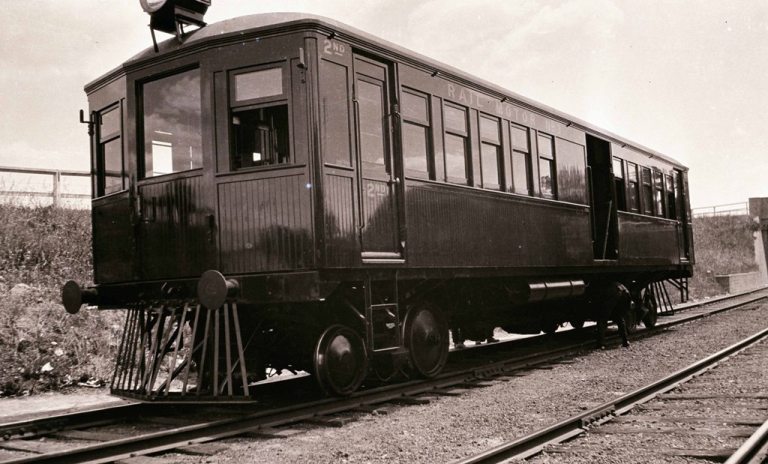
Rail Motor No.3 at Moss Vale during
its 1923 trial trip
Photo: The Preston Collection
ENGINES AND TRANSMISSIONS
The first four vehicles built (No.3-No.6) were fitted with a 6-cylinder 72 hp Thornycroft Z6 marine petrol engine. This engine was mounted with its attendant Thornycroft four-speed gearbox in the frame under the floor in the centre of the vehicle and all gears could be operated from either cab. It appears the Z6 engine did not perform as well as expected and two further engines were supplied by Thornycroft free of charge to replace defective units. No.1 (built 1927) and No.2 (built 1926) also received Thornycroft engines (these were probably the two replacement engines supplied by the manufacturers) when built but these were replaced with Leyland engines shortly after.
The next batch of vehicles was powered by a 6-cylinder 100 hp Leyland petrol engine coupled to an Eveleigh designed 4-speed gearbox, which became the standard fitting for many years. The Thornycroft engines in first four were replaced with the 100 hp Leyland between June and October 1924. These vehicles were geared for a road speed of 40 mph. The Leyland engine, being more powerful, allowed the rail motors to haul a trailer, when warranted by increased traffic demands. Two independent systems of ignition were fitted, a battery-fed ignition for starting and a high-tension magneto for running.
The manual gearbox was used to transfer power from the engine to the wheels and a clutch operated from a pedal in either cab was used to disengage the engine from the gearbox. Other auxiliaries that were belt driven from the engine were an air compressor and an electric generator. Reversing was achieved in the final drive. The reversing final drive featured dual crown wheels that were engaged pneumatically to select the direction of travel.
Radiators were mounted under the floor for cooling the engine and these were positioned along the outer side of he vehicle to obtain the best results. A fan was fitted to force air through the radiators and this system was arranged to obtain equal degrees of cooling for either direction of travel.
DEVELOPMENTS
The location of the radiators under the side of the vehicles proved to be unreliable as they easily became clogged with grass and dirt on the country branches over which they predominantly worked. As the only cooling medium was natural air circulation, the radiators were relocated to the roof at the No.2 end to provide greater cooling as more powerful petrol and diesel engines were fitted. A hand-operated pump supplied make-up water from a storage tank in the Guard's compartment to replenish water lost from the radiators.
In 1935, Rail Motor No.23 was fitted with a 6-cylinder 150 hp Leyland E47/1 petrol engine coupled to a Leyland Lysholm-Smith torque converter transmission. This Leyland engine and transmission was the same as that used in the twin-engined Rail Motor No.38 and the later 400 class. Between 1936 and 1946, the use of this engine was extended to No.2, 3, 5, 6, 15, 21, 30, 35 and 36. The Leyland Lysholm-Smith transmission was also fitted to No.2, 6, 15, 21, 30 and 36 between 1938 and 1941 in conjunction with the Leyland E47/1 engine.
A number of different engines were trialled in these vehicles. A 6-cylinder 150 hp A.E.C. petrol engine was installed in No.35 in 1933. This engine lasted until 1939 when it was replaced with a 10 litre Leyland. A 6-cylinder 185 hp Winton petrol engine was installed in No.30 in 1934 and another in No.25 in 1935. The unit in No.30 was replaced by a 10 litre Leyland in 1937, however, the engine in No.25 lasted until replaced by a GM diesel. The Winton engines were higher in profile than the available underframe clearance and protruded above floor level of the Guard's compartment. This required a raised false floor to be fitted. In 1939, a 6-cylinder 120 hp Leyland diesel engine with Lysholm-Smith transmission was fitted to No.18. The Leyland diesel proved very reliable and remained in service until replaced by a GM diesel in 1953.
In April 1945, a 6-cylinder 153 hp two-stroke General Motors Detroit Diesel Series 71 Model 6057 engine was fitted to No.12. This engine was coupled to a Twin Disc DFF 10024-TC-1L torque converter transmission and drove the inside axle on the bogie under No.2 End via a cardan shaft and a reversing final drive. The success of this engine and transmission combination led to it becoming the standard fitting for the CPH Class, No.38 and the three surviving 400 class members. By September 1956, the entire fleet had been converted to diesel power when No.27 was returned to service.
No.2 and No.19 were, for a period, fitted with a General Motors Allison TCLA 655 torque converter. This converter did not have a neutral position provided in the transmission as they were permanently coupled to the engine. This engine and transmission combination was used in the later 600 Class rail motors and these installations were probably for trials prior to the construction of the 600 Class. No.16 was fitted a Torcon transmission between 1949 and 1951. This was probably a trial installation for the transmission used in the 900 Class power cars. These three vehicles were not able to work in multiple with other members of the class until they were later fitted with the standard Twin Disc transmission.
The main auxiliaries, the air compressor and generator were coupled to the engine via shaft drives. The air compressor supplied air for the brakes, horn, sanding gear and other controls. The generator supplied power for battery charging, lighting, etc. Multiple unit working was possible when General Motors engines and their associated electro-pneumatic controls were fitted. Electrical control jumpers and air hoses were fitted and this enabled the rostered multiple unit (MU) working of up to five units.
During World War II, six of the class were fitted with gas producer units due to the shortage of petrol. The units fitted were No.6, 15, 21, 23, 30 and 36 and these units were all fitted with the Leyland 150 hp E47/1 engine. It is interesting to note that five of the six gas equipped units were destroyed by fire, while the gas equipment was removed from the sole survivor, No.6, after the War.
BOGIES
The first 32 vehicles were fitted with bogies that featured inside axle box journals, similar to steam locomotives. The welded steel disc wheels were constructed from 1/8" dished plate and were attached to a cast steel boss. These wheels proved troublesome and the steel thickness was later increased to 3/16". The first five cars had 2' 8½" diameter driving wheels with 2' 1" diameter wheels on the three non-driving axles. The remaining cars to No.32 had 2' 8½" diameter wheels on the power bogie and 2' 1" diameter wheels on the trailing bogie.
No.33 to No.37 were fitted with a light construction bogie with cast, spoked steel wheels and outside axle boxes. Wheel diameter was 2' 8½" and the bogies were classified 2QO. A roller bearing version of this bogie, coded 2QR, was fitted under No.35 and the No.2 end of No.36 in 1959.
A more substantial type of bogie, classified 2QG, was designed and replaced the earlier inside journal type on the first 32 vehicles from 1931 onwards. The 2QG type was developed from an earlier "G" type bogie, common on many passenger carriages. The 2QO and 2QR bogies under No.33 to No.37 were replaced with the 2QG pattern between 1964 and 1967. The wheel diameter on the 2QG bogie was 2' 8½". These bogies were originally fitted with spoked wheels, but these were later replaced by the cast disc type.
MULTIPLE UNIT WORKING
Before multiple unit working was available and two rail motors were required to run coupled together, a driver was required in each of the units. To synchronise the driving controls, a system of bell signals was set up to allow communication between the drivers. Trailers were not fitted with controls and this meant that when trailers ere used, the rail motor had to run round its trailer at each terminus. Rail motors were rarely coupled to other vehicles because of their light draw-gear.
Electro-pneumatic controls were installed with the introduction of the Detroit Diesel engine and Twin Disc transmission combination. In this system, electrically operated magnet valves allowed the operation of the torque converter (neutral, converter and direct drive) controls and direction (forward and reverse positions) by air pressure. The throttle remained pneumatic and was operated by a continuous pipe through the train. This enabled full multiple unit operation of up to five 42-foot type vehicles by a single driver. The limitation of five vehicles was imposed by the lag encountered with the pneumatic operation of the straight air brake and the throttle.
The original Rail Motors weighed 14 tons 14 cwt, but this has risen to 18 tons with the fitting of different engines and bogies. Rail Motors No.33 to No.37 have a tare weight of only 16 tons because of lighter bogies. The fuel tank, with a 70-gallon capacity, was mounted under the Guard's compartment floor. When GM diesels were fitted the tank capacity was increased to 96 gallons and this allowed a normal working range of over 600 miles (1,000 kilometres).
Light hook-type draw-gear, small buffers, cowcatchers and headlights were mounted at each end of the vehicle. Electric marker lights were fitted during the life of these vehicles. A safety feature to protect the train was a dead-man's pedal. If the driver became incapacitated and released the pedal, the engine is returned to the idle position and a warning buzzer is sounded in the guard's compartment. On hearing the buzzer the Guard would then activate the emergency brake air tap in his compartment.
The Rail Motors provided the postal service for line side communities on branch lines. The postal boxes were hung on brackets mounted outside the vehicle at each end and within easy reach for patron on the platforms.
Towards the end of their service lives, a number of the class were fitted with the so called "big cab" conversion. The provision of this facility was for safety reasons, allowing the Driver to be separated from the passengers and also providing a more spacious work area. A moveable seat was provided for the driver's use. Additional seating was also provided by a various combinations of single and/or double seats for the guard's use. The layout of the enlarged cab generally involved the removal of the first row of seats and the installation a fixed bulkhead between the first and second windows to create the separate driver's compartment. The majority of the original driver's cab was removed, leaving only the sidewalls adjacent to the front of the vehicle remaining. This modification could be made to either the No.1 or No.2 End. There was a consequent reduction in the seating capacity.
VEHICLE CONFIGURATIONS
|
|
|
|
|
|
|
|
|
|
SEATING
Initially fixed seating was provided throughout the class. This proved to be uncomfortable and about 1930 the rake of the seat backs was changed to provide more passenger comfort. Later, Hale and Kilburn rollover seating was provided in the saloons except for the smaller seats adjacent to the entry doors which remained fixed facing outwards towards the driver's cab. Seating capacity remained unchanged at 21 First Class and 24 Second Class.
In 1930, CPH 25 had all of the seating removed from the No.2 End and the space turned over to luggage and parcels. No.25, now with only First Class seating, was recoded BPH and allocated to Dubbo where it worked similar services to No.38.
Many seating layout variations were fitted during the life of the class. These variations generally involved removal of some seating to provide for additional luggage and parcel capacity. As vehicles passed through the workshops these changes were made depending upon the depot to which they were to be next allocated. Thus seating that was removed during one workshop visit may have been restored or further altered at the next.
There have been four major layouts that have been applied to a significant number of class members. These changes were internal in nature and the external appearance of the vehicle remained basically unchanged. The only outward external change was the notation DRIVER on the doors of those vehicles fitted with extended driver's cabs.
1960 - Seating was altered to 6 First Class and 30 Second Class. This configuration was applied to Nos. 1, 3, 4, 6, 7, 12, 14, 16, 18, 19, 24, 25, 27 and 31. CPH 26 was a variation
1969 - Seating was altered to 6 First Class and 26 Second Class. This configuration was applied to Nos. 1, 3, 4, 6, 7, 12, 14, 16, 18, 19, 24, 25, 27 and 31. Others with some form of extended luggage capacity were CPH 26 with 4 First and 26 Second Class, CPH 4 and 12 with 19 First and 24 Second Class and CPH 8 with 8 First and 24 Second Class.
1975 - No.1 End driver's cab was enlarged by placing a bulkhead between the first and second side walls adjacent to the front of the vehicle. A separate, moveable, seat was provided for the driver. Seating was altered to 14 First Class and 24 Second Class. This configuration was applied to Nos. 3, 8, 13, 19, 22, 27 and 33. No.11 was similar, however, seating class designations were reversed (24 First and 14 Second Class).
1975 - No.2 End driver's cab was enlarged similar to that applied to the No.1 End. Seating was altered to 21 First Class and 17 Second Class. This configuration was applied to Nos. 5, 12, 32, 33, 34, 36 and 37. No.6 was also fitted with an enlarged cab at the No.1 End but also retained the extended luggage compartment and seated 6 First Class and 17 Second Class.
TRAILERS
Three types of trailers were designed for use with the 42-foot Rail Motors. Bogie Trailers of the CTH and later CTC Class and the conversions of three old Redfern cars catered for increased passenger patronage, while the 4-wheel Parcels Trailers of the LT/GT Class catered for the increased parcels and light goods traffic.
COLOUR SCHEMES
When introduced, the 42-foot Rail Motors had a varnished natural timber finish. In 1927 an overall khaki finish was applied. This was later modified with red lining. A silver and blue scheme, similar to that used on the "Silver City Comet" was applied to some class members from 1937. Post World War II, a green and cream livery was introduced (the Rail Motor Society has adopted this scheme for their restored CPH's). The standard passenger car scheme of Tuscan red with a Russet brown band along the windows was adopted from the late-1940's. The final colour scheme was an overall Indian Red with Chrome Yellow lining.
|
Date |
Colour Scheme |
|
1923 |
Varnished timber finish |
|
1927 |
Khaki |
|
1928 |
Khaki and red |
|
1937 |
Silver and blue lining |
|
1945 |
Cream and green |
|
1949 |
Tuscan Red and Russet Brown |
|
1960 |
Indian Red and Chrome Yellow lining |
SERVICES
Following a succesful trial trip from to Sydney to Bombala and return on 7/8 Decemeber 1923, Rail Motor No.3 was placed into official service on 17 December 1923. Based at Culcairn, No.3 worked a thrice weekly service to Rand, followed by a thrice weekly service to Holbrook, commencing on 18 December 1923, which operated twice a day in each direction on Tuesdays, Thursdays and Saturdays. Both of these services were short lived, being terminated in November 1924.
By mid-June 1925, 12 units were in operation and services included Narranderra to Hillston and Tocumwal, Narromine to Cootamundra, Dubbo to Stuart Town and Gwabegar, Werris Creek to Tamworth and Binnaway, Burren Junction to Pokataroo and Walgett, Muswellbrook to Merriwa and Kyogle to Lismore. A further 10 units joined the fleet over the next 12 months with additional services being introduced, including Moree to Mungindi, Werris Creek to Narrabri West, Goulburn to Crookwell, Wyalong to Lake Cargelligo, Bogan Gate to Tottenham and Parkes to Cootamundra. By the end of 1927, 28 rail motors were in service and additional branch line services were introduced.
16 July 1928 saw the first use of rail motors in the Sydney Metropolitan area with the Bankstown to Lidcombe service. Other routes introduced around this time were Hornsby to Cowan and Sutherland to Waterfall. Further Metropolitan services were added, including Clyde to Carlingford and Canterbury Sidings, Liverpool to Campbelltown, Westmead to Rogans Hill and Kingsgrove to East Hills. Many of these services continued until ultimately replaced by the steady expansion of the suburban electrified network.
CPH rail motors continued to service country branches until their final withdrawal. Many were later concentrated in Sydney where they provided services on the Richmond Line, while a further group were based at Wollongong. These provided local services from Wollongong to Waterfall, Port Kembla, Kiama and Moss Vale. The Northern region had only limited services on the Muswellbrook to Merriwa Line, while one CPH was based in Newcastle to service the Belmont Line following the withdrawal of steam hauled trains. The CPH was required due to limited clearance in Fernleigh (Adamstown) Tunnel that prevented the use of 600/620/660 Class units. This service was withdrawn on 8 April 1971.
Individual rail motors were not generally dedicated to particular areas of NSW and were rotated with other units on a regular basis as they required workshop attention.
EPILOGUE
CPH's lasted well into the mid 1980's giving some sixty years of reliable service and even though retired from active service, many of these units are still in operation with various heritage operators in NSW. The Rail Motor Society is currently restoring and operating CPH type rail motors to ensure people can still experience these remarkable machines that were for so long the backbone of country branch line passenger services.
CPH 5 was preserved by the Steam Tram Preservation Society at Parramatta Park (Sydney). Unfortunately, it was destroyed by fire as a result of an arson attack on 7 June 1993.
REFERENCES
- "Rail Motors and XPTs" by David Cooke (Australian Railway Historical Society - 1984)
- "Rail Motors in NSW" by Rupert A Holloway (Institution of Engineers - 1928 - Reprinted 2003)
- "The Railways of NSW 1855-1955" (Department of Railways NSW - 1955)
- Research into early rail motors by Ron Preston
- NSWGR Drawings
- Drawings by John Hampson, Graham Staunton and Bruce Agland
